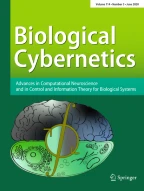Summary
This paper presents a new conception of information theory, which proved to be a generalisation of Shannon's information channel in the sense of a bidirectional communication. Consequently both, transmitter and receiver, are to be stochastic information generators. Transinformation is the result of a stochastic synchronisation process of one generator by the other, which process may occur in both directions. However the sum of both degrees of synchronisation is found to be limited to equal or less than one. Mathematically the theory describes the mutual statistical influence of two stochastic processes. Application to a quantitative description of communication between human beings is envisaged. Due to the fact that conscious processes are individually different, the corresponding information quantities are called “subjective.”
Similar content being viewed by others
Literatur
Marko, H.: Informationstheorie und Kybernetik. Vortrag, gehalten auf der Kybernetiktagg. Aug. 1965 in Kiel. Wien u. München: Oldenbourg.
Shannon, C. E.: A mathematical theory of communication. Bell Syst. techn. J. 27, 379–423, 623–653 (1948).
Jacobson, H.: The informational capacity of the human ear. Science 112, 143–144 (1950).
Jacobson, H.: The informational capacity of the human eye. Science 113, 292–293 (1951).
Fack, H.: Informationstheoretische Behandlung des Gehörs. Winckel, Impulstechnik, S. 280–338. Berlin-Göttingen-Heidelberg: Springer 1955.
Quastler, H.: Studies of human channel capacity. Third London Symposium on Information Theory (Editor C. Cherry), p. 361–371. London: Butterworths 1956.
Sziklai, G. C.: Some studies in the speed of visual perception. Trans. IRE, IT-2, 125–128 (1956).
Zwicker, E.: Die elementaren Grundlagen zur Bestimmung der Informationskapazität des Gehörs. Acustica 6, 365–381 (1956).
Miller, G. A.: The magical number seven; plus or minus two: some limits on our capacity for processing information. Psychol. Rev. 63, 81–97 (1956).
Pierce, J. R., and J. E. Karlin: Reading rates and the information rate of a human channel. Bell Syst. techn. J. 36, 497–516 (1957).
Quastler, H.: The complexity of biological computers. Trans. IRE, EC-6, 192–194 (1957).
Küpfmüller, K.: Informationsverarbeitung durch den Menschen. Nachr.techn. Z. 12, 2, 68–74 (1959).
Zemanek, H.: Elementare Informationstheorie, Kap. 2.44: Der Informationsfluß im Nervensystem. Wien u. München: Oldenbourg 1959.
Rosenblatt, F.: Principles of neurodynamics, perceptrons and the theory of brain mechanism. Washington D. C.: Spartan Books, McGregor and Werner 1962.
Steinbuch, K.: Die Lernmatrix. Kybernetik 1, 1, 36–45 (1961).
Widrow, B.: Generalization and information storage in networks of Adaline “Neurons”, p. 435–461. Washington, D.C.: Self Organizing Systems, Spartan Books 1962.
NTG 0102:Informationstheorie, Begriffe. Nachr.techn. Z. 46 (1963).
Henze, E.: Einführung in die Informationstheorie. Braunschweig: F. Vieweg & Sohn 1963.
Förster, H. v.: Das Gedächtnis. Eine quantenphysikalische Untersuchung. Wien: Franz Deuticke 1948.
McCulloch, W. S.: Brain, a computer with negative feedback. Trans. IRE, EC-5, 240–241 (1956).
Miller, G. A.: A note on the remarkable memory of man. Trans. IRE, EC-6, 194–195 (1957).
Neumann, J. v.: The computer and the brain. New Haven: Yale University Press 1958.
Good, I. J.: How much science can you have at your fingertips? IBM J. res. Dev. 2, 4, 282–288 (1958).
Sch/:afer, E.: Das menschliche Gedächtnis als Informationsspeicher; (dort weitere Literaturhinweise). Elektron. Rundschau 14, 3, 79–84 (1960).
Spälti, A.: Der Einfluß des thermischen Widerstandsrauschens und des Schroteffektes auf die Störmodulation von Oszillatoren. Bull. Schweiz, elektrot. Verein 39, 13, 419–427 (1948).
Frank, H.: Grundlagenprobleme der Informationsästhetik und erste Anwendung auf die mime pure. Waiblingen: Hess 1959.
Marko, H.: Physikalische und biologische Grenzen der Informationsübermittlung. Kybernetik 2, 6, 274–284 (1965).
Zemanek, H.: The logics and information theory of sequential networks. Automatic and Remote Control, Proc. of the IFAC-Congr., Moskau 2, 845–852 (1960).
Author information
Authors and Affiliations
Additional information
Meinem verehrten Lehrer Herrn Prof. Dr. rer. nat., Dr.-Ing. E. h. Richard Feldtkeller zum B. Geburtstag gewidmet.
Der Verfasser dankt seinen Mitarbeitern Herrn Dipl.-Ing. G. FÄRBER und Herrn Dr. E. NEUBURGER für zahlreiche Diskussionen und für wertvolle Hinweise bei der Aufstellung der Formeln.
Der Deutschen Forschungsgemeinschaft und der Fraunhofer-Gesellschaft sei für die Unterstützung der Forschungsarbeiten gedankt.
Rights and permissions
About this article
Cite this article
Marko, H. Die Theorie der bidirektionalen Kommunikation und ihre Anwendung auf die Nachrichtenübermittlung zwischen Menschen (Subjektive Information). Kybernetik 3, 128–136 (1966). https://doi.org/10.1007/BF00288922
Received:
Published:
Issue Date:
DOI: https://doi.org/10.1007/BF00288922
